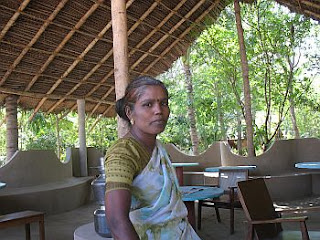This is a bird commonly seen around Arunachala, particularly around Samudram Erie, which gets nice and marshy during rains. This morning I had one of these birds sitting outside my garden - probably didn't come in because way too much competition from crows dropping by for breakfast, lunch and dinner . . . !!!. Yes, the colours are magnificent and authentic, the White-breasted Kingfisher REALLY does look like this.

The White-breasted Kingfisher (Halcyon Smyrnensis) is found on plains and lower hills all over India and is very common at Tiruvannamalai. This Kingfisher is not dependent upon water and although seen at ponds, puddles and rain filled ditches also habitates light forests situated considerable distances from water. From a favourite lookout on a telegraph wire or post, the Kingfisher pounces down on creeping prey and flies off with it to another perch nearby where the victim is battered to death and swallowed. This bird's food comprises; fish, tadpoles, lizards, grasshoppers, insects and occasionally young birds and mice
This Kingfisher is a beautiful bird that never fails to get attention. It is a brilliant turquoise-blue with deep chocolate-brown head, neck and underparts, a conscious white ‘shirt front’, and long, heavy, pointed red bill. A white wing-patch prominent in flight. It’s size is that between a Myna and a Pigeon. Both sexes are alike but juveniles are a duller version of the adult.
This is a large Kingfisher, 28 cm in length with a flight both rapid and direct with short rounded wings whirring. This bird has a loud musical frequently repeated chattering song delivered from a tree top or some exposed elevated perch. The call is a chuckling chake-ake-ake-ake-ake. This Kingfisher is noisy and territorial. Nesting season is principally March to July and generally takes place in a horizontal tunnel dug into the side of a dry earth cutting or tunnel. Eggs 4 to 7, white, spherical. Both sexes excavate, incubate and feed the young.
This Kingfisher is a beautiful bird that never fails to get attention. It is a brilliant turquoise-blue with deep chocolate-brown head, neck and underparts, a conscious white ‘shirt front’, and long, heavy, pointed red bill. A white wing-patch prominent in flight. It’s size is that between a Myna and a Pigeon. Both sexes are alike but juveniles are a duller version of the adult.
This is a large Kingfisher, 28 cm in length with a flight both rapid and direct with short rounded wings whirring. This bird has a loud musical frequently repeated chattering song delivered from a tree top or some exposed elevated perch. The call is a chuckling chake-ake-ake-ake-ake. This Kingfisher is noisy and territorial. Nesting season is principally March to July and generally takes place in a horizontal tunnel dug into the side of a dry earth cutting or tunnel. Eggs 4 to 7, white, spherical. Both sexes excavate, incubate and feed the young.











